Tattoo Removal Blisters
A Comprehensive Guide to Understanding, Treating, and Preventing
Understanding Tattoo Removal Blisters
After laser treatments, the common effects can range from nothing at all to dry, itchy or blistering skin. Just like the human body naturally sends signals for the blood to clot and form a scab as a defence against bacteria entering the open wound, blisters are a natural indication that everything is going well with the ink removal process from your skin.
Blistering after laser tattoo removal is a perfectly normal reaction to the procedure, and should not be cause for alarm. Developing blisters is a positive indication that the healing process is going as planned, and that the ink is being removed from your body.
This guide will discuss:
- What to expect after a laser tattoo removal procedure
- Why blisters occur during the healing process
- Step-by-step guidance for treating tattoo removal blisters
- Complete aftercare instructions for optimal healing
The Science Behind Laser Tattoo Removal
How Laser Tattoo Removal Works
Step 1: Targeting the Ink
Lasers shoot high-intensity light through your top layer of skin, directly hitting the larger pigments of tattoo ink.
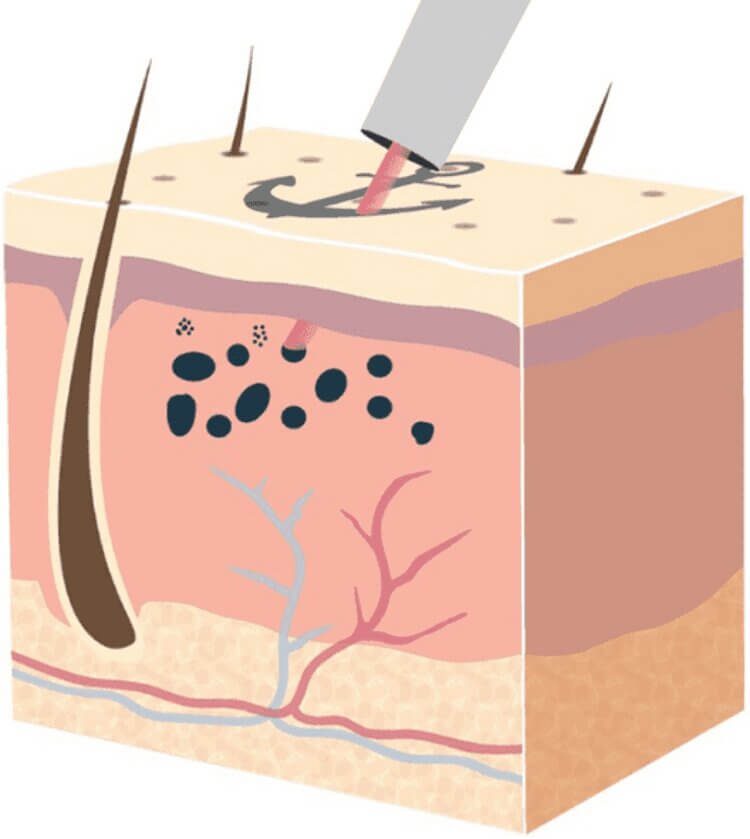
Step 2: Breaking Down Ink
The tattoo ink absorbs this energy, causing the particles to heat up and shatter into smaller fragments.
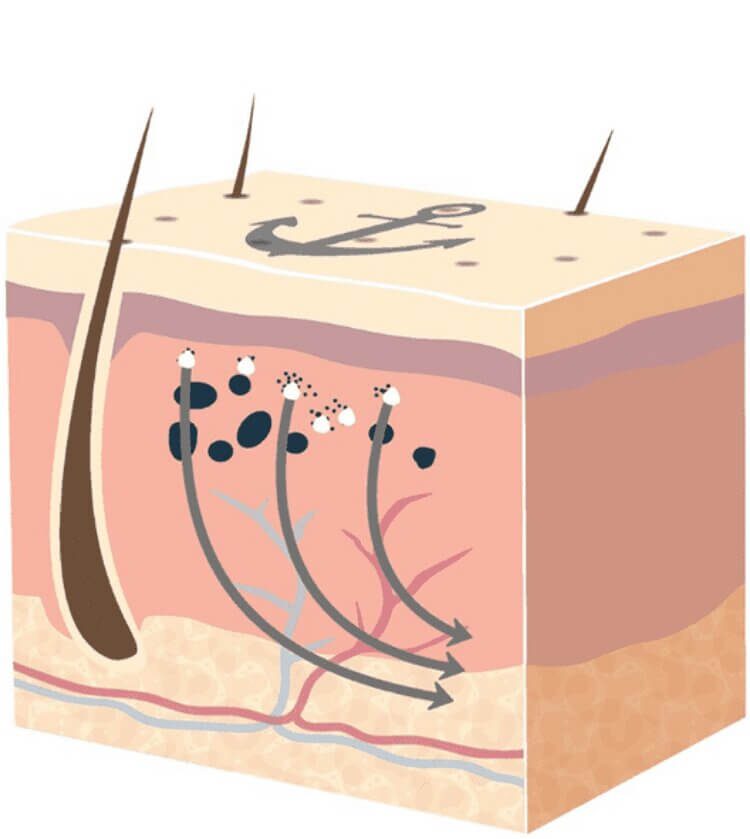
Step 3: Immune Response
Your body’s immune system recognizes and removes these smaller ink particles through the lymphatic system.
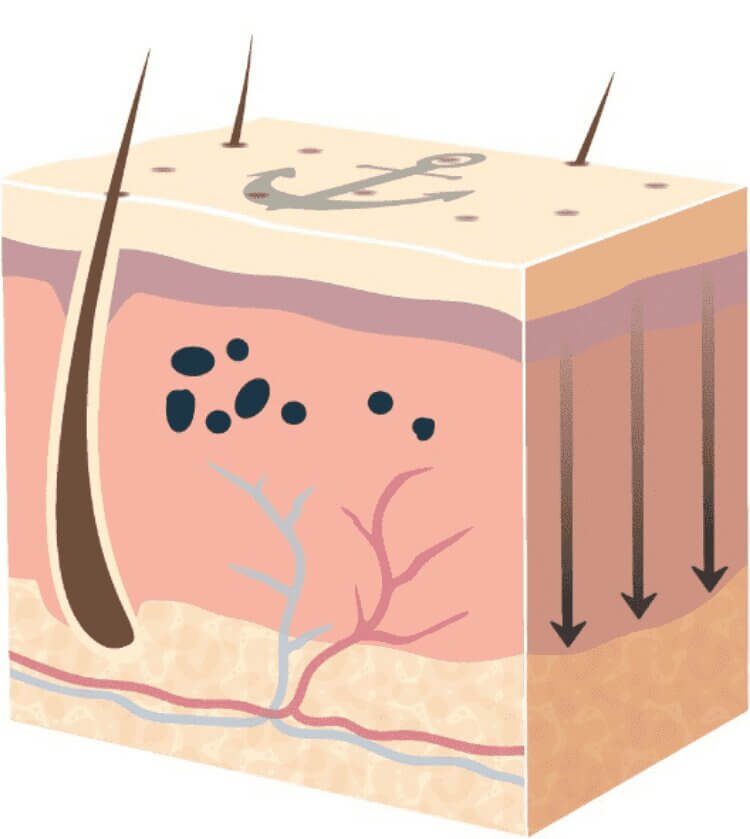
During the tattoo removal process, the laser projects intense heat onto the treated area to cause the tattoo ink particles to disintegrate. As those particles disrupt, so do the surrounding blood vessels.
Modern laser technologies like PicoWay use photoacoustic effects that gently target the ink using sound energy rather than heat. The incredibly short pulses last for one trillionth of a second, making the process extremely gentle compared to other removal treatments.
Why Do Tattoo Removal Blisters Occur?
Blisters occur when your body produces fluids within your skin. In this case, the skin is excreting water and tattoo ink.
Important Facts About Blistering:
- Blisters are NOT burns – They’re a natural immune response, not damage from the laser
- Blisters contain broken-down ink particles being expelled from your body
- The closer the tattoo is to your heart, the more blood it receives and potentially fewer blisters
- Tattoos on extremities (hands and feet) are more likely to blister due to less blood circulation
- Blistering typically begins 8-72 hours after treatment
Blister Myths:
MYTH:
Blisters mean something went wrong during the procedure.
FACT:
Blisters are a normal reaction and indicate that the body is healing and processing the ink particles.
MYTH:
Blisters will always lead to scarring.
FACT:
When properly cared for, blisters rarely cause scarring. They are a temporary part of the healing process.
Tattoo Removal Before and After Results
These before and after images show the progression of tattoo removal treatment. Notice how the skin heals completely after proper care.
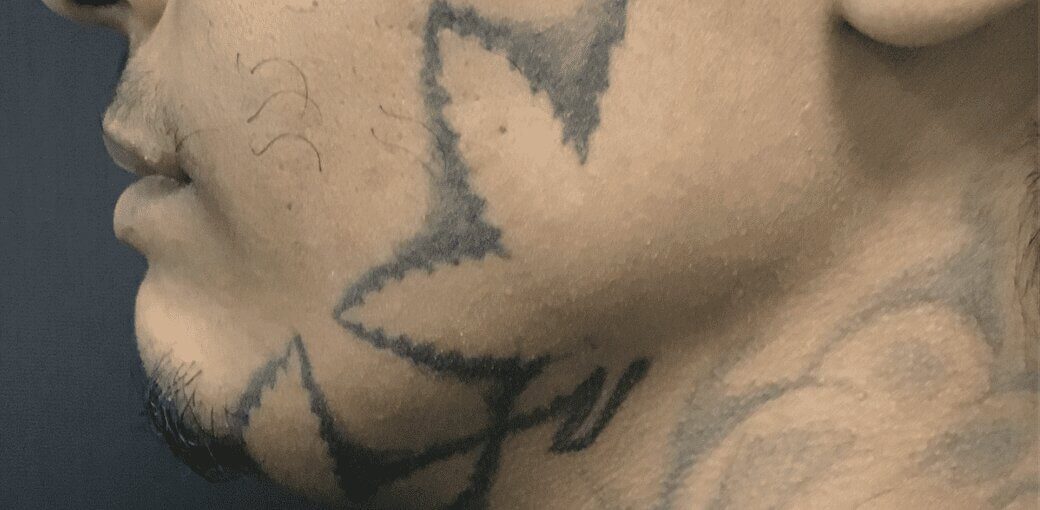

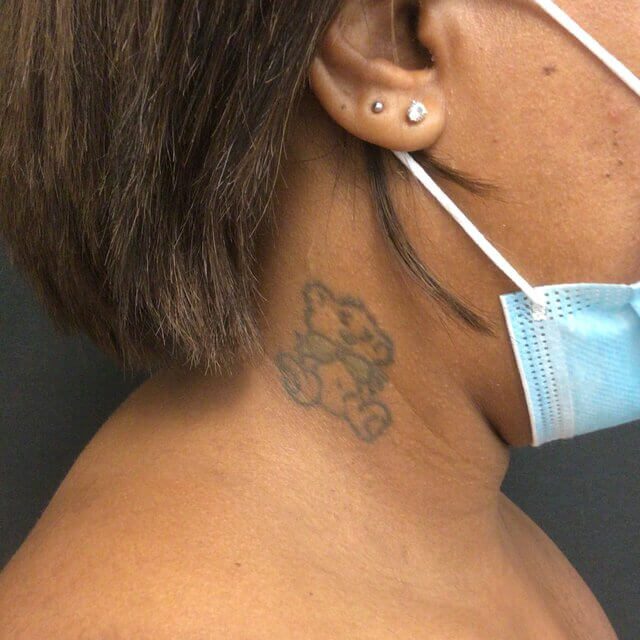
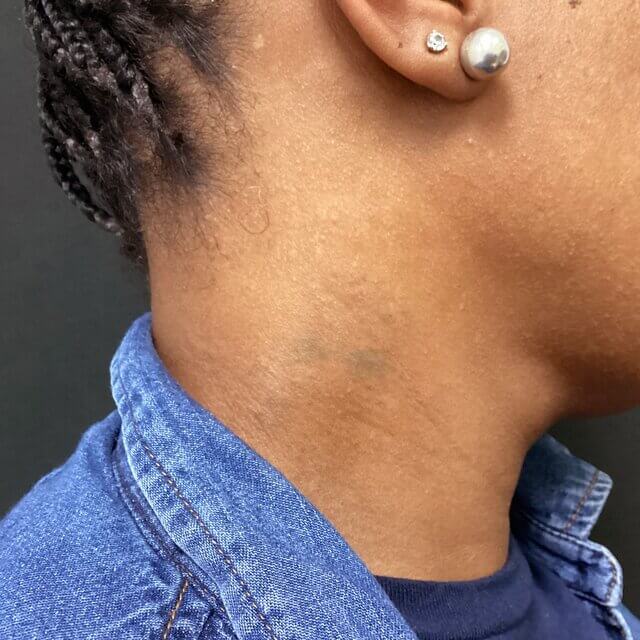
How To Treat Laser Tattoo Removal Blisters
Immediate Care After Laser Treatment
-
Apply ice packs
Apply ice packs to the treated area immediately to reduce discomfort and swelling. Elevate the area if possible.
-
Clean the area
Keep the area clean and dry. Use mild soap and lukewarm water to gently clean the treated area. Pat dry with a clean towel.
-
Apply antibacterial ointment
Apply antibacterial ointment to the skin regularly throughout the day and refresh the bandage or dressing as necessary, once per day minimum.
-
Let blisters heal naturally
Allow the blisters to pop and ooze naturally, rather than popping them prematurely yourself due to scratching or scraping. The excreted liquid from the blisters will crust and scab naturally as part of the healing process.
-
Avoid picking at scabs
Do not scratch or pick at the scabs. As the scabs begin to fall off naturally over time, you might notice your skin tone around the affected area discolouring slightly. This is only temporary.
How to Drain a Blister (If Necessary)
While it’s generally best to let blisters heal naturally, in some cases – particularly for large blisters (larger than a quarter) or those in high-friction areas – proper drainage may be recommended:
- Gently clean the area with non-fragranced soap and water, being careful not to pop the blister.
- Using a sterile tool (like a lancet or needle), make one small hole at the base of blister to let the fluid drain. Catch the fluid with a gauze or a paper towel.
- Do not pick or remove the skin- this is your body’s natural protection.
- Cover the area with a non-stick bandage.
- Keep the area clean with non-fragranced soap and apply a thin layer of Vaseline.
Important: Only drain blisters if they are painful, at risk of tearing, or located in high-friction areas. Otherwise, let them heal naturally.
Tattoo Removal Healing Timeline
Understanding the typical healing stages after laser tattoo removal can help set expectations and ensure proper care. Here’s what to expect:
Immediately After Treatment
Expect redness, swelling, and a “frosting” effect (whitish appearance) on the treated area. This is normal and typically subsides within 30 minutes.
- Apply ice packs to reduce swelling
- Keep area clean and covered with antibacterial ointment
8-72 Hours After Treatment
This is when blisters typically form. They contain fluid and tattoo ink that your body is expelling.
- Continue applying antibacterial ointment
- Let blisters heal naturally – don’t pop them
- Keep the area clean and protected
First Week
Blisters may begin to drain naturally and form crusts or scabs. The body continues to flush out broken-down ink particles.
- Keep the area clean and moisturized
- Don’t pick at scabs or crusts
- Protect from sun exposure
Weeks 2-6
Scabs fall off naturally, revealing new skin underneath. Redness gradually fades. The body continues to remove ink particles through the lymphatic system.
- Continue to protect from sun exposure
- Moisturize regularly
- Avoid scratching or picking
6-8 Weeks
Healing is typically complete. This is usually when you can safely undergo your next treatment session. The tattoo will appear lighter as ink has been removed.
- Evaluate results with your technician
- Prepare for next session if needed
- Continue sun protection for treated area
Preventing Complications and Infection
Sun Protection
Sun exposure can cause hyperpigmentation and complicate the healing process. The treated area will be particularly sensitive to sunlight.
- Wear sunblock with a minimum SPF of 25 for at least 3 months after treatment
- Cover the treated area with clothing when outdoors
- Avoid tanning beds completely
Avoid Hot Water
Heat can increase swelling and irritation, delaying recovery.
- No hot baths, showers, or saunas for at least 48 hours
- Stick to lukewarm showers
- No swimming pools, hot tubs, or ocean swimming until fully healed
Keep it Clean
Preventing infection is critical for proper healing.
- Clean the area with mild soap and water
- Change bandages daily
- Apply antibacterial ointment as directed
- Avoid makeup, lotions, or creams on the treated area
Warning Signs of Infection
Though rare, infections can occur. Watch for these signs:
- Increasing pain or swelling after 3 days
- Pus or yellow/green discharge
- Fever or chills
- Red streaks extending from the treatment area
If you notice any of these signs, contact your tattoo removal specialist or seek medical attention immediately.
Optimizing Your Healing Process
Factors That Enhance Healing
Hydration
Drink plenty of water to help your lymphatic system flush out the ink particles more efficiently.
Exercise
Regular exercise improves circulation and immune function, which helps remove ink faster.
Avoid Smoking
Smoking hinders the immune system and can prolong healing time between treatments.
Dietary Considerations
What you eat can affect how quickly you heal. Consider incorporating these elements into your diet:
- Anti-inflammatory foods (berries, fatty fish, leafy greens)
- Foods rich in vitamin C to promote collagen production
- Foods high in zinc to aid wound healing
- Adequate protein for tissue repair
Frequently Asked Questions
Is blistering normal after laser tattoo removal?
Yes, blistering is a common side effect of laser tattoo removal. It indicates your skin’s healing response to the treatment and is part of the normal process as your body expels ink particles.
How long do blisters last after laser tattoo removal?
Blisters typically heal within 1 to 2 weeks after the treatment. Proper aftercare can expedite this process and reduce the risk of complications.
Can I pop a blister caused by laser tattoo removal?
No, you should not pop blisters as it increases the risk of infection and scarring. Let them heal naturally. If a blister is large or particularly uncomfortable, consult your technician for proper drainage techniques.
What immediate care should I follow after laser tattoo removal?
Apply a cold compress to reduce swelling and discomfort. Keep the area clean and dry, and apply an antibiotic ointment if advised by your technician.
Can tattoos be 100% removed?
While we cannot assure 100% clearing of tattoos, many people do achieve complete removal. Results vary based on the density and depth of ink used, your body’s ability to absorb and remove the ink, and factors like tattoo age, color, and location.
How many sessions are needed for complete tattoo removal?
Most tattoos require between 5-12 sessions for complete removal, with sessions spaced 6-8 weeks apart. Factors affecting the number of sessions include ink color, tattoo age, location, and your body’s ability to clear the ink.
How do I know if my tattoo removal is infected?
Signs of infection include excessive pain or swelling, pus or green/yellow discharge, red streaking from the area, fever, or chills. If you notice these symptoms, seek medical attention immediately.
Why do I feel sick after tattoo removal?
Some people experience flu-like symptoms as the body processes broken-down ink particles. This is typically temporary and not cause for concern, but staying hydrated can help alleviate these symptoms.
Is it normal to not have blisters after laser tattoo removal?
Yes, not everyone experiences blistering. Reactions vary based on individual skin types, the location of the tattoo, and the type of laser used. The absence of blisters doesn’t mean the treatment wasn’t effective.
What are the long-term side effects of tattoo removal?
Possible long-term effects may include hypopigmentation (lighter skin), hyperpigmentation (darker skin), or subtle scarring. These risks are minimized when treatments are performed by experienced technicians using high-quality equipment.
Conclusion
Blisters are a normal part of the tattoo removal healing process, signaling that your body is working to eliminate the broken-down ink particles. While they may look concerning, proper aftercare ensures they heal without complications.
Remember these key points:
- Blisters are a normal reaction, not a complication
- Follow proper aftercare instructions to prevent infection and scarring
- Let blisters heal naturally rather than popping them
- Complete healing typically takes 6-8 weeks between sessions
- Always consult with your tattoo removal specialist if you have concerns
With patience and proper care, you can navigate the tattoo removal process successfully and achieve the results you’re looking for.